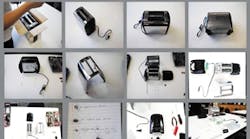Just about every company around the globe wants to be green. The question is, what does this really mean and how is “green” actually quantified? One method is to use software dubbed a life cycle assessment (LCA) tool that brings metrics and measurement to product design.
One program in this category comes from Sustainable Minds LLC, Cambridge, Mass., which has corporate clients including Kohler, Caterpillar, Motorola, 3M, and Xerox. SM is optimized for electromechanical products, including household appliances, housewares, consumer electronics, industrial and commercial equipment, and outdoor and sporting goods.
SM also says 300 colleges and universities use its software for training. For example, Sinan Erzurumlu, assistant professor in technology and operations management at Babson College, leads a course which focuses on a life cycle approach to sustainable innovation. Students participate in consumer choice projects, using SM to analyze, validate, and defend product choices.
“As they gain skill in using LCA software, they begin to make critical business decisions that impact the environmental sustainability of product performance. One student even launched a company based on a product idea that matured as a result of taking this course,” says Erzurumlu.
One of the key projects during his course involves students selecting just six pieces of clothing to wear for two weeks. During this time, they evaluate the environmental impact of each garment using the software and come up with ways to improve the sustainability of each item. The idea is to encourage students — as future business leaders — to rethink consumerism and take a holistic view of product life cycles.
Richard Braunstein, adjunct professor at Georgia Tech and director of product development at YKK AP, teaches a course on sustainable product design that uses SM for LCA topics throughout product development. He says he covers all aspects of a sustainable product design process, from raw material and bulk processing through the manufacture, assembly, product use, and end-of-use choices, such as refurbishment, recycling, or landfill disposal. His students use SM as an evaluation tool to assess decisions in the iterative design process for an array of consumer products, from kitchen toasters to power drills.
“Students learn to integrate environmental considerations throughout the design process using SM, and I try to dispel the myths surrounding single-attribute ‘greenwashing,’ where a product is touted as greener in one aspect while remaining environmentally harmful in other aspects,” says Braunstein.
He says the chief objective of his class is to prepare students who will address product design from a broader perspective, integrating environmental responsibility into the core of the design process. Braunstein says over the 10 years he has taught the course, he has heard from several former students who have gone into industry and brought about change, citing his course as a key factor.
In a similar endeavor, St. Louis University launched a Master of Sustainability degree program in August 2010. As part of the program, Sri Condoor, professor of aerospace and mechanical engineering, has students use SM to design, test, build, and demonstrate either a solar-powered oven or an eco-friendly toaster for a consumer in a particular country. SM software is then used to determine the finished product’s carbon footprint and overall environmental impact.
Resources
Sustainable Minds, www.sustainableminds.com
